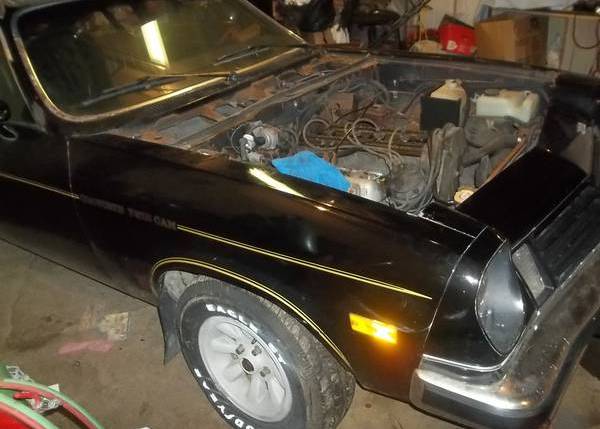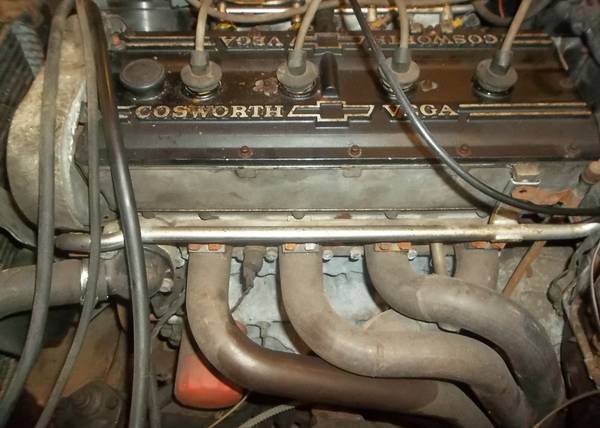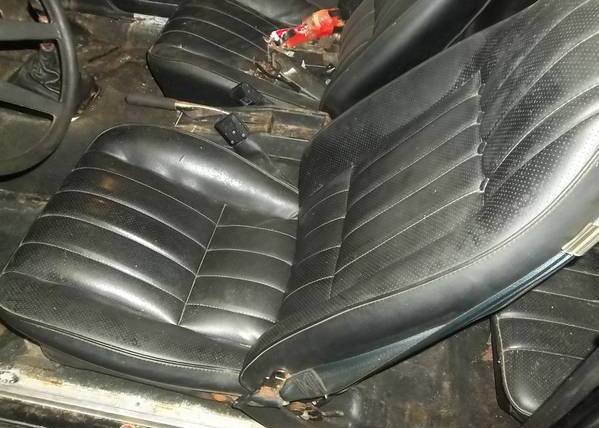
From a very young age, the name “Cosworth” got my blood pumping. In most cases, it designated some form of a brawny rally car, thanks to Cosworth’s heavy involvement in Ford’s racing program in the 80s and early 90s (which was when my obsession over anything with 4 wheels was really coming into its own). But Cosworth was not solely a Ford UK exclusive, as it also partnered with marques like Mercedes-Benz to produce the Autobahn-storming legend that is the 190E 2.3-16, a shot across the bow to BMW’s E30 M3. With all that history, it begs the question why a 1975 Chevy Cosworth Vega found here on craigslist in Milwaukee is disassembled and awaiting a new owner to respect its rarity and limited production.

The Cosworth Vega was John DeLorean’s project, representing another chapter in his oftentimes unsettled history with GM. But what a concept – take the underwhelming Vega and pair it a Cosworth-engineered head to breathe some life into the fuel-conscious compact. Today’s economy cars occasionally get performance variants but they don’t ever seem to have the cache of their forbearers. I suppose that can be said about every generation of automobiles, but when you throw in the slick black paint and gold-painted alloy wheels, it becomes a tribute-in-miniature to the Bandit’s Trans Am – not a bad association to have.

My first memory of a Cosworth Vega was seeing it in a local 4th of July parade when I was likely no taller than the car’s fender. I believe I still have a photograph of the car somewhere, rolling down the street among the likes of typical parade-fodder vehicles – Mustang, Corvettes, old Cadillacs, Mercedes convertibles… The Vega stood out, and I suspect most people in the crowd didn’t even know what they were looking at. It’s amazing to think of what cars we’re drawn to even at a young age and how that interest sticks with you for years to come. Who knows why I thought the Vega was the star of the show. But all these years later, I still dig it when factories make hot rods out of their most meager performers.

This Cosworth on Craigslist has definitely seen better days. It hasn’t been run in decades (20 years!) and the motor is likely terminally stuck. Of course, when originally conceived, the Cosworth Vega surpassed GM’s requirements to drive at full load for 200 hours by enduring the test at 500 hours of flat-out pedal hammering. While that means little for a car laid up as long as this one has been, it is encouraging to think that with two engine blocks and sets of pistons to work with, the next owner might be able to make a running example out of Cosworth #1913. So tell us – is this high-performance hatchback worth bringing back, or is this one example that’s been stalled for too long? Let us know in the comments section.


Looks like someone thought it was worth saving!
Looks like the posting has been deleted, maybe it has sold already. ’75 was the first year of the 5-mile per hour bumpers, they look pretty “obtuse” on this poor Vega.
Hey, at least it HAS bumpers. Unlike the newer cars that have the bumper cover attached to the fenders to ensure heavily transferred damage to the fenders.
.
” Factory Tuned “………. heading should say “DETUNED” !
.,
By the time they got into production, EPA caused the concept motor to finally be ANEMIC.
.
The ’76 I had was a total disappointment, when it came to performance….even after upgrading with a set of dual Weber sidedrafts
Don’t drive one Jeff, your dream will be forever shattered……
I remember Norvell Chevrolet having one of these ,and thinking how cool , but the price I believe was pretty high for a Vega, almost 2 years later they still had the Vega sitting in a corner of the service dept , I ask why no one had bought it and the salesmans reply was , once purchased and used the value was no more than a used Vega even with the special motor . I remember seeing where the person who assembled the motor signed his name on a little plaque on the motor . Salesman told me to buy it and store it away for 20 years and then maybe it would be worth the asking price .
How much was it for sale for? If it was $2500 or less that would have been GREAT! Most people with Cosworth Vegas think they have a future AACA classic on their hands and want ridiculous prices for them. I wouldn’t have been surprised to see something in this condition in the $5-7.5k range…all for a truly crappy car with a very nice drivetrain! >_<
i wonder if they bought this just for the motor/drivetrain. nice find
Were the blocks upgraded on the Cosworth cars? Reason I ask I can still recall back in HS circa 1973-74 when an older rich kid’s father purchased a brand new non-Cosworth Vega for him. He was so proud of his shiny new ride-until it had about 1500 miles on it and began the infamous oil consumption problem and then had to have a new motor installed. The new motor didn’t last much longer than the original and they really took a bath getting rid of it as by then word had gotten out about what a junk engine block “government motors” had allowed out. This was one of three new Vegas I knew of that all had the same thing happen to them. The only Vegas I ever saw running long term were all V8 conversions and perhaps one or two Cosworths. As I also recall the ‘sleeve fix’ rarely ever worked well and GM should have been severely punished for ever foisting that POS upon the public. Just MHO…
General Motors was trying to advance the technology of aluminum casting for engine blocks, having had extensive experience with the 215 v-8 used by Buick and Oldsmobile. Remember that the profits for these compact cars was very slim and so they wanted to devise a way to avoid the need for costly iron/steel cylinder sleeves as were used in the 215. GM partnered with Alcoa if memory serves to find a way to add silica to the alloy to make the cylinder as wear resistant, or more than cast iron.
Lacking sleeves, which help to maintain the dimensional stability of the block, GM specified cast iron for the stock cylinder head to help keep the block stiff and straight. Except for it’s overhead cam it was otherwise unremarkable, offering little performance potential. So GM reached out to Cosworth for a performance head. The timing though was unfortunate given the need to meet ever tightening emissions reduction targets. That of course adversely affected ALL manufacturers. (Porsche’s answer was the 930 Turbo). So the improvements in flow from the Cosworth head were overwhelmed by the loss of performance new emission control systems, which were in their earliest stage of development caused. The Cosworth Vega never really had a chance.
The Cosworth is an interesting variant, but Vegas in general, along with a friend’s Fiat 124 Sport Coupe, win my award for fastest rusting cars ever (when stored outside, rockers and fenders could rust from inside out in as little as two years)
I rented a Vega on a trip back when they were new and was impressed with the handling, which was pretty good for that time. I wasn’t as impressed with the NVH problems. It was and still is the buzziest car on the highway that I can recall ever driving.
After that I had a girlfriend who owned Pontiac’s version, the Astre. It used a lot of oil for a fairly new car and leaked between the windshield & surround so much that she had to hang a can under the dash to catch the water—and it rained all winter where we were living back then. She took it into the Pontiac dealer many times for that under warranty but they never were able to stop the flow.
I thought the one I bought and put 90,000 miles on was number 1913, maybe it was number 1917? Other than going through three clutch cables, and needing to re-torque the head occasionally, it still looked brand new and had factory rated compression when I sold it. Smog rules neutered the power potential. Not as good as many European cars on bumpy surfaces, but at the time outperformed any contemporary US produced car in the hills of Northern California.
The high silica content alumnum blocks were made in a huge die casting press. The free standing cylinder bores were then acid etched so that oil would have a chance to lubricate the pistons. There was a problem with initial production blocks in that the silica would not stay evenly distributed throughout the block. The blocks then had a tendency to warp which aggravated the oil leakage problem. The main problem was the free standing cylinder bores that would fret against the head gasket, wearing it and resulting in leaks and premature failure. Various efforts were made to cure this and the most successful with the Cosworth heads was the careful machining of a groove into the top of the free standing cylinder. A gas filled Dykes compression ring was then inserted into the groove that accomplished two objectives; good head gasket to block sealing and stabalizing of the cylinder to prevent fretting. A well set up Cosworth Vega engine with these and other mods, no pollution controls, could be turned into a real screamer of a smal displacement engine. Pontiac finally gace up and put the 4 cylinder “Iron Duke” into the Astra.
Funny how some of GM’s best cars are the last ones of the series. i.e. Cosworth Vega, Cadillac Cimmeron DeOro, Fiero GT and a whole bunch of Pontiacs got wiped out like the G8 (and El Camino version) and even the Solstice IMHO
..There sure is a lot of unfounded hype here about these cars…
…During the late 60’s and early 70’s, US Automakers didn’t have a clue about a lot of what was going on in the world, regarding manufacturing techniques and engine design..and it culminated about the time Chevrolet put this car into the market, causing them much embarrassment and financial loss… following the failure of the Corvair design(s), which was only a few years earlier..
The Cosworth Vega did not have ‘performance’ … unless you compared it to the stock Vega, of most of the other pitiful cars being offered by US manufacturers of the time…
Detroit, ,not EPA was responsible for this, as proven by the many import cars that passed EPA Regs, and still had good performance. The similar Fiat 124 Coupe mentioned above was about 2 seconds faster 0 – 60, and a couple SECONDS quicker in the Qtr Mile …with 10% less displacement
The motor is a composite, not a ‘great design’ like the sbc or the Lampredi twincam
The Cosworth Vega was short on power, handling was marginally ok, had a poor ride, and no overdrive.
They were never competitive on the race track….that should say a LOT
.
Unlike some of the above commenters, I actually owned and drove one for a while.
………. When I sold mine, I was GLAD to see it go….
Didn’t one of the mags do a off road version that had 200+ HP?
We had one at the dealership where I was a salesman. It wasn’t much better than a regular Vega till 3000 rpm. It was then you noticed the difference. still it wasn’t the greatest performer. I think the cost was too high. We never sold it. The owner put it away in his collection.
I worked on Cosworth Vegas in 1975 and 1976 in Chicago. I was the Chevrolet Zone “Specialist” and probably had a hand on every one in the area at least once. The car needed RPM to make more power. The engine was 2.0 liters compared to the standard Vega issue of 2.3. The list price of the car in 1975 was close to the price of a 1975 Corvette StingRay. Only advantage to the Cosworth may have been insurance rates? Which one would you choose for the same money?
Interesting fact: The Cosworth was the First American car brought to market with an electronic fuel management system. It was designed by Bendix and they supplied an analog diagnostic tool to help figure out what might be going wrong. Of course now everybody uses an on-board computer to mix fuel and air for the engine, but the Cosworth Vega was the 1st!
I remember these cars when new. They were interesting, but as everyone pointed out, the price was too high. The biggest issue with this car was that it was a Vega. It was already known as a crappy car and adding a Cosworth engine wasn’t going to save it.
In 1979 I worked part-time during high school for a imported car parts store in St. Louis. A guy that worked there used to race a Cosworth Vega in Showroom Stock class.
I had one of these back in the eighties. I saw one in the showroom at the chevy dealer and you could buy a Vega GT for just over 2 grand, and the cossy was almost 7 grand. I found a low mile one and drove it foe about 4 years. It ran great and I surprised a lot of V8 vegas that were popular back then. I never had a problem with it the whole time I owned it, other than the clutch cable problems all vega owners know about. I got rid of it because I was worried that something in the timing belt, or the FI was going to go bad, and the technology was new to me. I would like to have it back, but then I want all my old cars back.